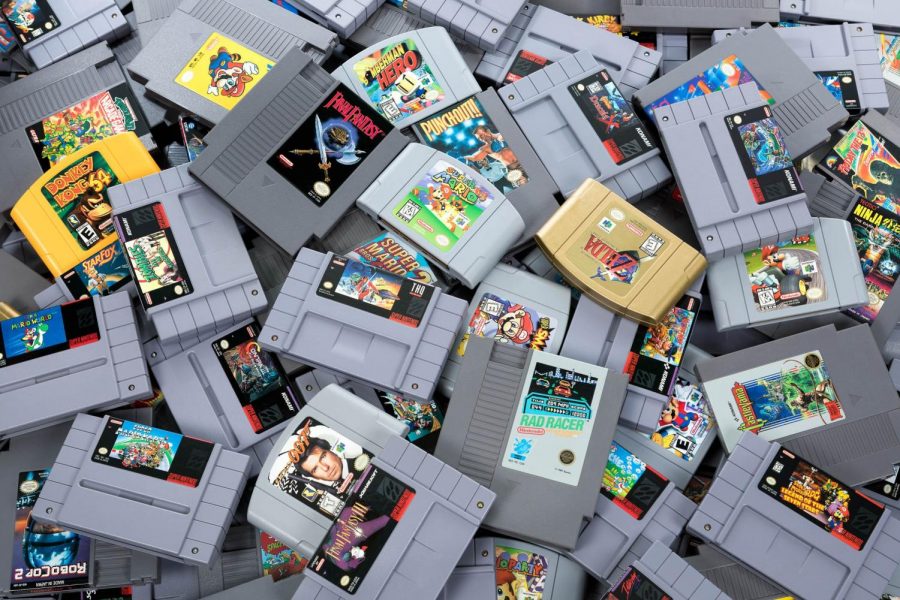A Look into the History of Game Design
Photo Credit: Getty Images
A pile of NES, SNES, and N64 games.
October 26, 2021
Millions of people have played video games before. Although we can all argue which games are better than others, there are also the games that push the boundaries of design. But which games were groundbreaking in design?
Pong could be seen as one of the first video games with a design, albeit very simple compared to newer titles. It’s a two player game of ping-pong. Nolan Bushnell, founder of Atari, then conceptualized Breakout as a single-player version of Pong, where the goal is to eliminate all of the blocks on the other side of the board without losing balls.
Games like Space Invaders and Pac-Man shortly followed. These arcade games were developed as quarter-suckers, designed to be addictive and entertaining to the players, as well as onlookers. Nowadays, these games are still fun to play, but they can get stale quickly, as with older arcade games there wasn’t much variation in levels.
Quickly afterwards came the Video Game Crash of 1983. It was a large recession in the video game industry after a flood of poor-quality or confusing games released, primarily on the Atari 2600. This event led Nintendo, which was still pretty new to the industry, to change things up. When they released the Nintendo Entertainment System (NES) in the U.S., they needed a pack-in title to attract interest in video games again. So they created Super Mario Bros., which is now one of the best-selling games of all time, and for good reason.
While the purpose of many games at the time was to eat up quarters at the local arcade, Super Mario Bros. was an evolution in 2D platformers. It served as a killer app for the NES, and was one of the major factors in reviving the video game industry after the 1983 crash.
At almost the same time, Nintendo developed The Legend of Zelda, which was designed to be the complete opposite of Mario’s gameplay. Zelda was an adventure in an open world, filled with dungeons, puzzles, and bosses. Dragon Quest (or Dragon Warrior when it was released originally in the U.S.) was another RPG (Role Playing Game) that came out in 1986. Zelda was the first Action-RPG, while Dragon Quest was the first turn-based RPG.
Most games from then on usually added one gimmick to an already-established game archetype. That is, until 3 dimensions came into the picture. The original Playstation, Nintendo 64 and Sega Saturn/Dreamcast were the consoles that introduced 3 dimensional gameplay and problems. Up until this point, the player could only move in two directions, how do you design a fun game with three?
Super Mario 64 was the game that started the process of designing for 3D. Compared to Super Mario World (which had over 80 levels, with multiple different themes), Super Mario 64 is puny in terms of worlds with only 15 worlds. But Nintendo designed around that and put multiple objectives in each world, so that the game could fit in one cartridge. Because of that smart design choice, the game has aged incredibly well.
There was also Doom, which was the first modern First-Person Shooter (FPS). It took the groundwork from its predecessor Wolfenstein 3-D and created a fully-3D environment to run around and kill demons in. Most modern FPS engines still have roots that trace back to the original Doom engine.
Games afterwards would build on top of the foundation that Mario 64 and Doom created. There were multiple pioneering games in this era, like Goldeneye 007, Banjo-Kazooie, The Legend of Zelda: Ocarina of Time, Call of Duty, and Quake.
Then, in 2001 (20 years ago this month), Grand Theft Auto III launched. Taking place in the New York-inspired Liberty City, it gave a sense of freedom to complete any mission in any method of the player’s choosing, as there weren’t many restrictions built into the game. The game’s controversial appeal made it spike in notoriety among consumers. Rockstar Games would later release two sequels on the PS2, Vice City and San Andreas, the latter of which is the best-selling game on the PS2. And for a while, GTA III was the first true open-world game. Other games pushed the boundaries of open-world games even further, which includes both Minecraft and The Elder Scrolls V: Skyrim.
After many years, the next big push for game design came from The Legend of Zelda: Breath of the Wild. While previous open-world games had missions that you had to complete in a certain order and in the same places to complete the game, Breath of the Wild took a left turn in its organization. Instead, the areas to get more powerful were spread out across the map, and it put the player’s starting location in the center, making the world feel more grand than many other open-world games.
Games have changed a lot over time, and it’s been fun to take a look back at the history of why these games are so much fun to play.



